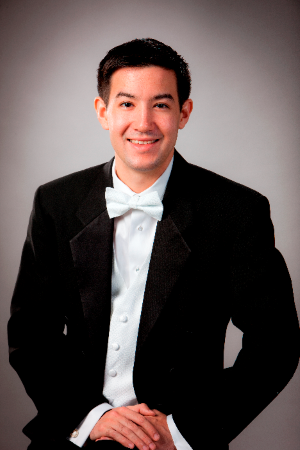The Last Days of Lecce-Chong
Milwaukee Symphony Associate Conductor Francesco Lecce-Chong's second last gig here is all-choral concert.
Milwaukee Symphony Orchestra Associate Conductor Francesco Lecce-Chong will perform his penultimate concert to sold-out audiences at Basilica of Saint Josephat this weekend. Many may know Lecce-Chong for his work conducting the series of cathedral-based concerts at times when the Marcus Center for the Performing Arts is used for opera or ballet. He has begun a new position as Assistant Conductor with the Pittsburgh Symphony Orchestra, but in his last gig for the MSO, he will also conduct the five Messiah performances at several venues December 16 through 20.
In recent concerts, Lecce-Chong has been selecting more contemporary works that fit the cathedral settings. For this concert he will conduct the Milwaukee Symphony Chorus in an all-choral program featuring two composers whose deep faith was often the basis for composition – Henryk Górecki and Anton Bruckner.
Górecki was little known outside of Poland, living most of his life in the Southwestern Silesian region. As a contemporary composer, he began by writing “radical modernist” works. His personal style matured into a form of serial composition well suited to his religious vocal compositions.
In 1976, Górecki wrote his third symphony, the Symphony of Sorrowful Songs, Op. 36, incorporating texts which capture the grief of parent and child. The first movement incorporates a 15th century lament by Mary, mother of Jesus. The second movement features a daughter’s note to her mother written on the wall of a Gestapo prison. And the song in the third movement expresses a mother’s grief for a son lost in a regional Silesian war in the early 20th century.
A remarkably simple structure dominates the opening movement. A canon beginning with a solo bass steps through a harmonic progression while adding string sections with each step. A new entry begins every 25 measures, each starting a diatonic fifth above the last. A nearly imperceptible sound grows at a nearly glacial pace until the full string orchestra is engaged. The stage is set for the first sorrowful song. The movement fades away in a similar fashion until silence returns.
The three sorrowful songs will be sung by soprano Kathryn Henry, a UW-Milwaukee senior who rose through the highly competitive Metropolitan Opera National Council Auditions to participate in the finals in New York last spring. Critic Richard Sasanow of BWWOperaWorld. com praised her “clean coloratura and silvery voice.”
Górecki’s music is captivating. The pace should work well within the notorious acoustic of the Basilica. But I suspect the best selling album was most often heard over candlelight, a bottle of wine, incense and perhaps other mood inducers. Symphony audiences may have less patience for a 54 minute work with few fireworks or mood changes. However, the grandeur of the Basilica should be inspiring enough.
Górecki taught in a small music academy, the State Higher School of Music in Katowice for most of his life. When Cardinal Karol Józef Wojtyła became Pope John Paul II, the stage was set for a bloodless rebellion against Poland’s Communist government. In 1979, Górecki resigned from the school and started a local branch of the “Catholic Intellectuals Club,” a group offering a low-key resistance to the government.
Górecki has written many powerful religious works for chorus. Dubbed “sacred minimalism,” his choral compositions are simple in basic structure. Repeated words and themes are subject to changes in timing and dynamic but little else. These meditative works reflect Medieval modes as much as contemporary. The chorus and orchestra will perform Totus Tuus, written in 1987 for Pope John Paul II and based upon the Pope’s motto reflecting his commitment to Mary — “I am yours, always.”
Bruckner will be featured in a powerful work that should fill and perhaps overload the Basilica. He wrote Te Deum in C major in 1884 near the end of his life. The text, a hymn of praise frequently a part of Catholic services, has often been the inspiration for composers. Bruckner’s music offers a clear contrast with Gorecki’s 20th century works. Bruckner offers the drama and detail of traditional German classical music – with a full voice unison choral opening, a tender section for tenor and solo violin, a quartet of operatic solo voices and a joyous full fugue to close. Four soloists (soprano Ariana Douglas, mezzo-soprano Katherine Fili, tenor Thomas Leighton and bariton Leroy Y. Davis) join the symphony and chorus.
The Milwaukee Symphony concert begins at 8:00 P.M. Friday, November 13 and Saturday, November 14. The Basilica of Saint Josephat is located at 2333 S 6th St, Milwaukee. There will be no pre-talk, but the open-seating may mean you need to arrive early.
Preview
-
A Sacred Choir, 70 Voices Strong
 Dec 14th, 2025 by Martha Brown
Dec 14th, 2025 by Martha Brown
-
Prometheus Trio Goes Bohemian
 Dec 3rd, 2025 by Martha Brown
Dec 3rd, 2025 by Martha Brown
-
Present Music Offers New Choral Works
 Nov 20th, 2025 by Michael Barndt
Nov 20th, 2025 by Michael Barndt




















